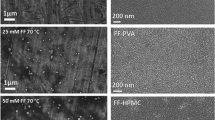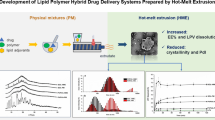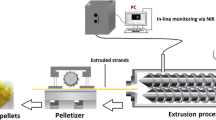Abstract
The aims of this study are to develop polymeric films loaded with nanoparticles of fenofibrate (FNB), a poorly water-soluble drug, prepared via melt emulsification (ME) and study the short-term physical stability of the ME-based suspensions, with the ultimate goal of enhancing FNB dissolution. FNB particles in water were heated above the melting point to form an oil-in-water emulsion, whose cooling turned FNB droplets into solidified FNB nanoparticles. The resulting FNB suspensions, along with a suspension of as-received FNB, were mixed with hydroxypropyl methylcellulose (HPMC)–glycerin solution to prepare film precursor suspensions, which were then casted and dried into films. The effects of the presence of Pluronic F68 (PF68) as stabilizer and the sonication during the cooling step on the physical stability of the suspensions were investigated. For films, drug content, redispersibility, and drug release in a USP IV dissolution test were studied. The results show that cooling the FNB–PF68 emulsion in the presence of sonication produced suspensions with acceptable 7-day physical stability, whereas cooling the same without sonication led to severe particle aggregation within 20 min. The film redispersion in water led to effective recovery of FNB nanoparticles only when PF68 and sonication during the cooling step were used. Good drug content uniformity and enhanced FNB dissolution were obtained from the films containing FNB nanoparticles stabilized with PF68, but the impact of sonication on the FNB dissolution was not discernible. Overall, feasibility of films carrying ME-based drug nanoparticles for enhanced dissolution has been demonstrated.







Similar content being viewed by others
References
Amidon G, Lennernäs H, Shah V, Crison J. A theoretical basis for a biopharmaceutic drug classification: the correlation of in vitro drug product dissolution and in vitro bioavailability. Pharm Res. 1995;12:413–20.
Bruno J, Doty B, Gustow E, Illig K, Rajagopalan N, Sarpotdar P. Method of grinding pharmaceutical substances. US Patent. 1996;5(518):187.
Merisko-Liversidge E, Liversidge G, Cooper E. Nanosizing: a formulation approach for poorly water-soluble compounds. Eur J Pharm Sci. 2003;18:113–20.
Bhakay A, Merwade M, Bilgili E, Davé R. Novel aspects of wet milling for the production of microsuspensions and nanosuspensions of poorly water-soluble drugs. Drug Dev Ind Pharm. 2011;37:963–76.
Noyes A, Whitney W. The rate of solution of solid substances in their own solutions. J Am Chem Soc. 1897;19:930–4.
Zhang J, Shen Z, Zhong J, Hu T, Chen J, Ma Z, et al. Preparation of amorphous cefuroxime axetil nanoparticles by controlled nanoprecipitation method without surfactants. Int J Pharm. 2006;323:153–60.
Shen S, Ng W, Chia L, Dong Y, Tan R. Stabilized amorphous state of ibuprofen by co-spray drying with mesoporous SBA-15 to enhance dissolution properties. J Pharm Sci. 2010;99:1997–2007.
Jansook P, Kurkov S, Loftsson T. Cyclodextrins as solubilizers: formation of complex aggregates. J Pharm Sci. 2010;99:719–29.
Muller M, Peters K. Nanosuspensions for the formulation of poorly soluble drugs: preparation by a size reduction technique. Int J Pharm. 1998;160:229–37.
Bilgili E, Afolabi A. A combined microhydrodynamics–polymer adsorption analysis for elucidation of the roles of stabilizers in wet stirred media milling. Int J Pharm. 2012;439:193–206.
Knieke C, Azad M, Dave R, Bilgili E. A study of the physical stability of wet media-milled fenofibrate suspensions using dynamic equilibrium curves. Chem Eng Res Des. 2013;91:1245–58.
Li M, Yaragudi N, Afolabi A, Dave R, Bilgili E. Sub-100 nm drug particle suspensions prepared via wet milling with low bead contamination through novel process intensification. Chem Eng Sci. 2015;130:207–20.
Mehnert W, Mader K. Solid lipid nanoparticles production, characterization, and applications. Adv Drug Deliv Rev. 2001;47:165–96.
Li X, Gu L, Xu Y, Wang Y. Preparation of fenofibrate nanosuspension and study of its pharmacokinetic behavior in rats. Drug Dev Ind Pharm. 2009;35:827–33.
Kocbek P, Baumgartner S, Kristl J. Preparation and evaluation of nanosuspensions for enhancing the dissolution of poorly soluble drugs. Int J Pharm. 2006;312:179–86.
Knieke C, Rawtani A, Davé R. Concentrated fenofibrate nanoparticle suspensions from melt emulsification for enhanced drug dissolution. Chem Eng Technol. 2014;37:157–67.
Köhler K, Henselb A, Krautb M, Schuchmanna H. Melt emulsification—Is there a chance to produce particles without additives? Particuology. 2011;9:506–9.
Huang Q, Wang J, Zhang Z, Shen Z, Chen J, Yun J. Preparation of ultrafine fenofibrate powder by solidification process from emulsion. Int J Pharm. 2009;368:160–4.
Verma S, Kumar S, Gokhale R, Burgess DJ. Physical stability of nanosuspensions: investigation of the role of stabilizers on Ostwald ripening. Int J Pharm. 2011;406:145–52.
Ghosh I, Bose S, Vippagunta R, Harmon F. Nanosuspension for improving the bioavailability of a poorly soluble drug and screening of stabilizing agents to inhibit crystal growth. Int J Pharm. 2011;409:260–68.
Bilgili E, Li M, Afolabi A. Is the combination of cellulosic polymers and anionic surfactants a good strategy for ensuring physical stability of BCS Class II drug nanosuspensions? Pharm Dev and Technol. 2015. doi:10.3109/10837450.2015.1022788.
Lee J. Drug nano- and microparticles processed into solid dosage forms: physical properties. J Pharm Sci. 2003;92:2057–68.
Van Eerdenbrugh B, Froyen L, Humbeeck J, Martens J, Augustijns P, Mooter G. Drying of crystalline drug nanosuspensions—the importance of surface hydrophobicity on dissolution behavior upon redispersion. Eur J Pharm Sci. 2008;35:127–35.
Bhakay A, Bilgili E, Dave R. Recovery of BCS Class II drugs during aqueous redispersion of core–shell type nanocomposite particles produced via fluidized bed coating. Powder Technol. 2013;236:221–34.
Abdelwahed W, Degobert G, Fessi H. Investigation of nanocapsules stabilization by amorphous excipients during freeze drying and storage. Eur J Pharm Biopharm. 2006;63:87–94.
Sievens-Figueroa L, Bhakay A, Jerez-Rozo J, Pandya N, Romañach R, Michniak-Kohn B, et al. Preparation and characterization of hydroxypropyl methyl cellulose films containing stable BCS Class II drug nanoparticles for pharmaceutical applications. Int J Pharm. 2012;423:496–508.
Beck C, Sievens-Figueroa L, Gärtner K, Jerez-Rozo JI, Romañach RJ, Bilgili E, et al. Effects of stabilizers on particle redispersion and dissolution from polymer strip films containing liquid antisolvent precipitated griseofulvin particles. Powder Technol. 2013;236:37–51.
Krull S, Susarla R, Afolabi A, Li M, Ying Y, Iqbal Z, et al. Polymer strip films as a robust, surfactant-free platform for delivery of BCS Class II drug nanoparticles. Int J Pharm. 2015;489:45–57.
Susarla R, Figueroa L, Bhakay A, Shen Y, Jerez-Rozo J, Engen W, et al. Fast drying of biocompatible polymer films loaded with poorly water-soluble drug nanoparticles via low temperature forced convection. Int J Pharm. 2013;455:93–103.
Jamzad S, Fassihi R. Role of surfactant and pH on dissolution profiles of fenofibrate and glipizide—a technical note. AAPS Pharm Sci Tech. 2006;7:E1–6.
Figueroa L, Pandya N, Bhakay A, Kevyan G, Michniak-Kohn B, Bilgili E, et al. Using USP I and USP IV for discriminating dissolution rates of nano- and microparticle-loaded pharmaceutical strip-films. AAPS PharmSciTech. 2012;13:1473–82.
Baird J, Eerdenbrugh B, Taylor L. A classification system to assess the crystallization tendency of organic molecules from undercooled melts. J Pharm Sci. 2010;99:3787–806.
Sanganwar G, Gupta R. Nanomixing of dipyridamole drug and excipient nanoparticles by sonication in liquid CO2. Powder Technol. 2009;196:36–49.
Ding P, Pacek A. De-aggregation of goethite nanoparticles using ultrasonic communication device. Powder Technol. 2008;187:1–10.
Kusters K, Pratsinis S, Thoma S, Smith D. Ultrasonic fragmentation of agglomerate powders. Chem Eng Sci. 1993;48:4119–27.
Bhakay A, Azad M, Bilgili E, Dave R. Redispersible fast dissolving nanocomposite microparticles of poorly water-soluble drugs. Int J Pharm. 2014;461:367–79.
Heck J, Deleer M, Fanara D, Vranckx H, Amighi K. Preparation and characterization of nanocrystals for solubility and dissolution rate enhancement of nifedipine. Int J Pharm. 2005;299:167–77.
Venkatesh G, Barnett M, Owusu-Fordjour C, Galop M. Detection of low levels of the amorphous step in crystalline pharmaceutical materials by thermally stimulated current spectrometry. Pharm Res. 2001;18:98–103.
Acknowledgments
The authors gratefully acknowledge financial support from the National Science Foundation Engineering Research Center for Structured Organic Particulate Systems through the Grant EEC-0540855. We also thank Dr. B. Patel, Dr. M. Azad, and Mr. S. Krull for providing valuable comments on an earlier draft of this manuscript.
Author information
Authors and Affiliations
Corresponding author
Rights and permissions
About this article
Cite this article
Bhakay, A., Vizzotti, E., Li, M. et al. Incorporation of Fenofibrate Nanoparticles Prepared by Melt Emulsification into Polymeric Films. J Pharm Innov 11, 53–63 (2016). https://doi.org/10.1007/s12247-015-9237-2
Published:
Issue Date:
DOI: https://doi.org/10.1007/s12247-015-9237-2




